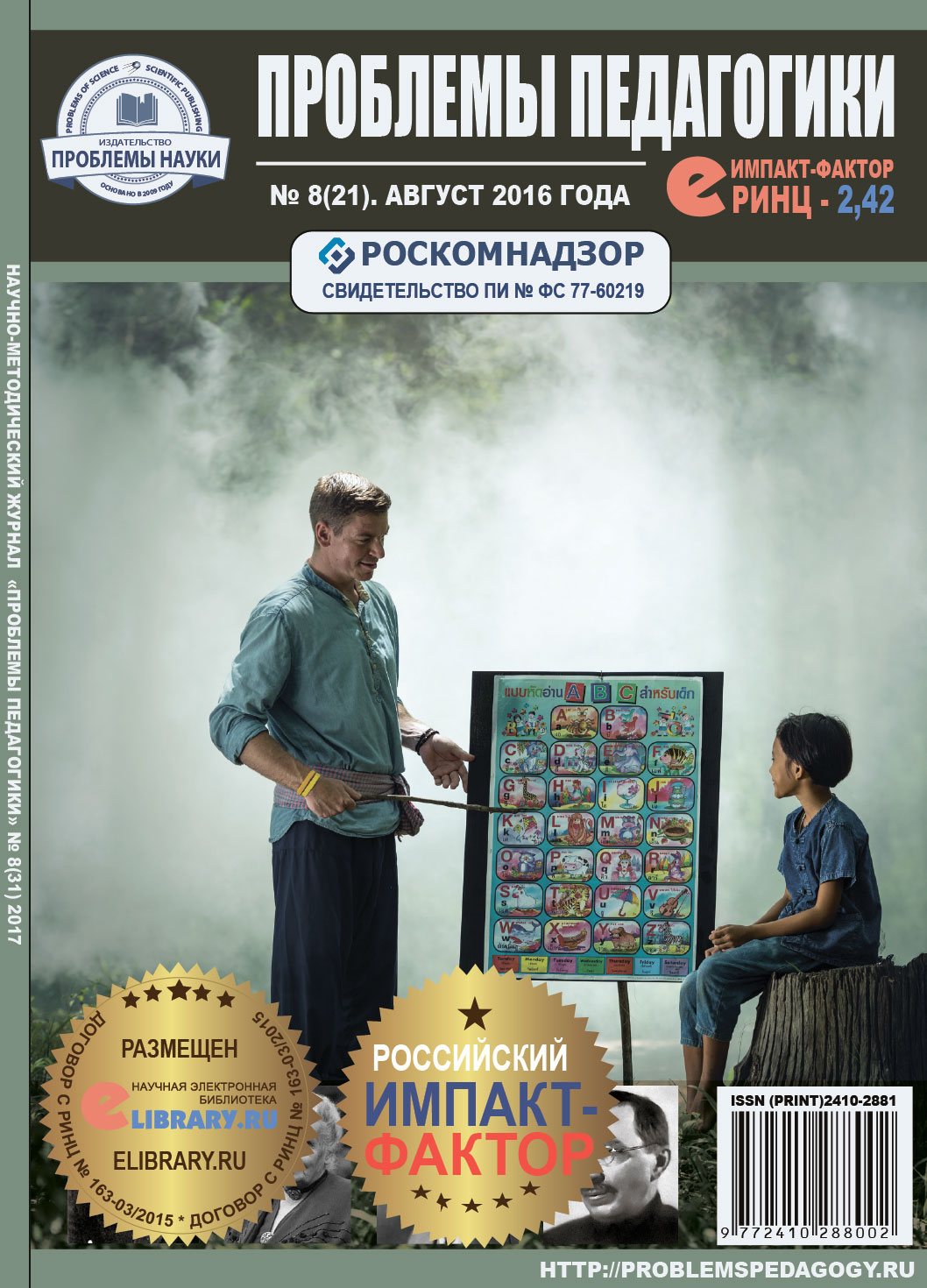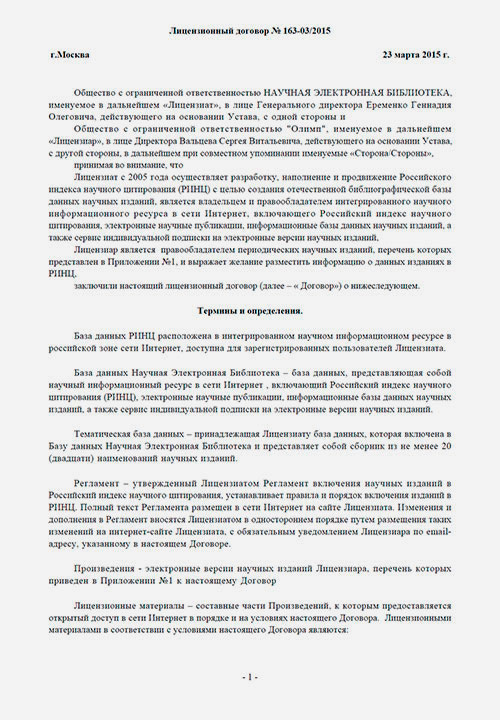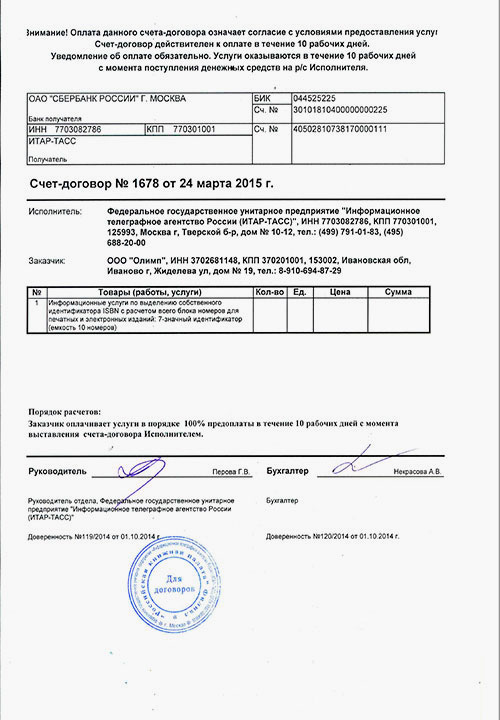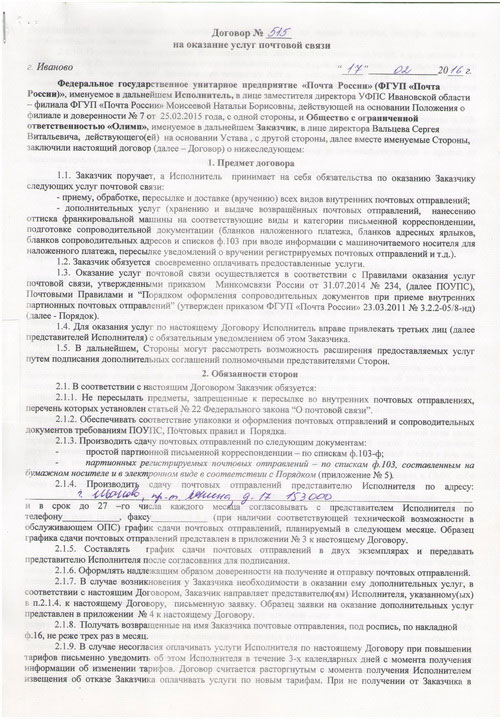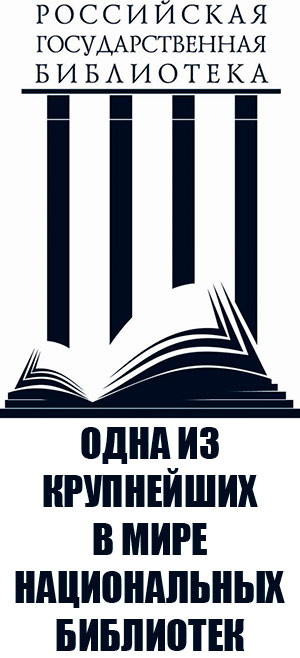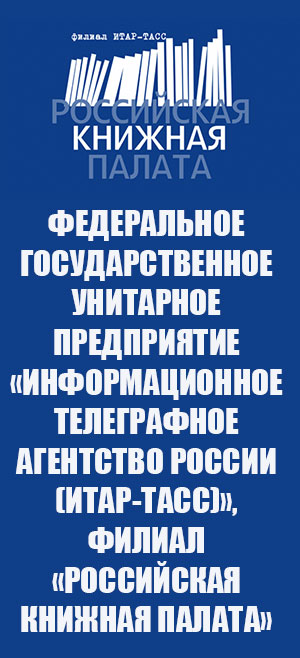Наши договора

СРОЧНЫЙ ОТТИСК
УНИКАЛЬНОЕ ПРЕДЛОЖЕНИЕ. ТОЛЬКО В ИЗДАТЕЛЬСТВЕ «ПРОБЛЕМЫ НАУКИ»
Не дожидаясь выхода печатной версии журнала, сразу после выхода электронной версии, мы высылаем автору следующий комплект документов.
1. Справка о публикации + 2. Распечатанные страницы из журнала со статьёй автора. Документы с живыми (мокрыми) печатями и подписями главного редактора. По желанию автора, печатный сертификат.
Журнал еще не покинет типографию, а комплект срочного оттиска уже будет у Вас!
Стоимость срочного оттиска 90 руб. Без доставки.
Если Вам нужен срочный оттиск, напишите это в письме.
подробнее >>>
Кратко и просто о eLIBRARY и РИНЦ. Все научные издания разделяются на те, которые включены в eLIBRARY и те, которые включены РИНЦ. Публикации, входящие в РИНЦ - более авторитетная часть публикаций на eLIBRARY. Публикации на eLIBRARY и в РИНЦ учитываются как результат научной работы автора и в показателях его цитируемости. Разница в том, что у авторов существует индекс Хирша по всем публикациям на eLIBRARY.RU, а также индекс Хирша по публикациям в РИНЦ. На данный момент все издания издательства «Проблемы науки» входят в eLIBRARY.
Бесплатный официальный сертификат
| |
|
Платный сертификат
|
|
Бесплатный сертификат
|
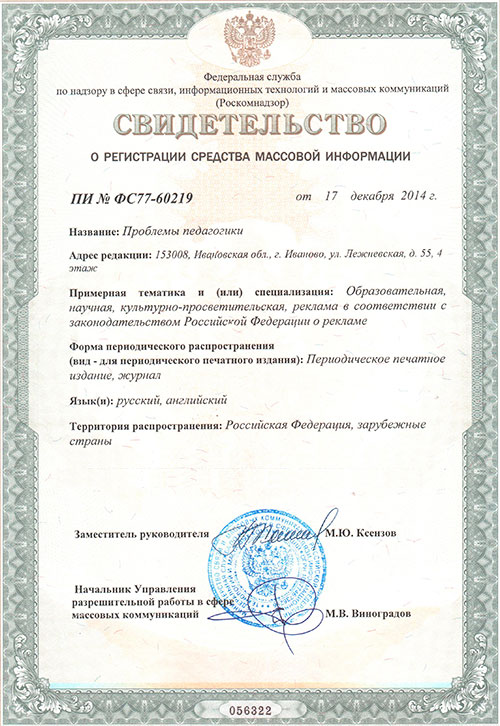 |
|
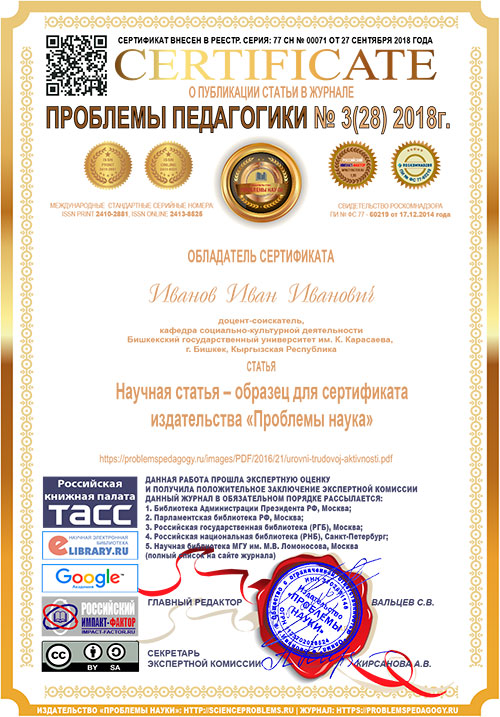 |
|
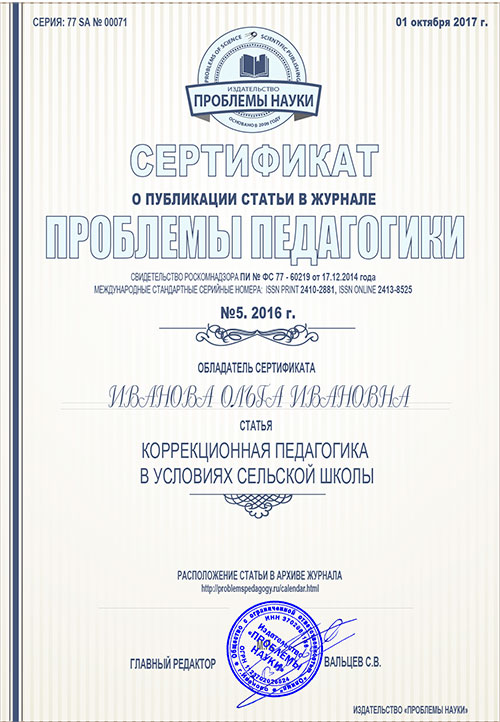 |
Авторы журнала «Проблемы педагогики», по их желанию, получают сертификат о публикации статьи. Предусмотрено как платная, так и бесплатная форма сертификата о публикации. Также Редакция предоставляет бесплатно официальную справку о публикации.

Моментальная публикация
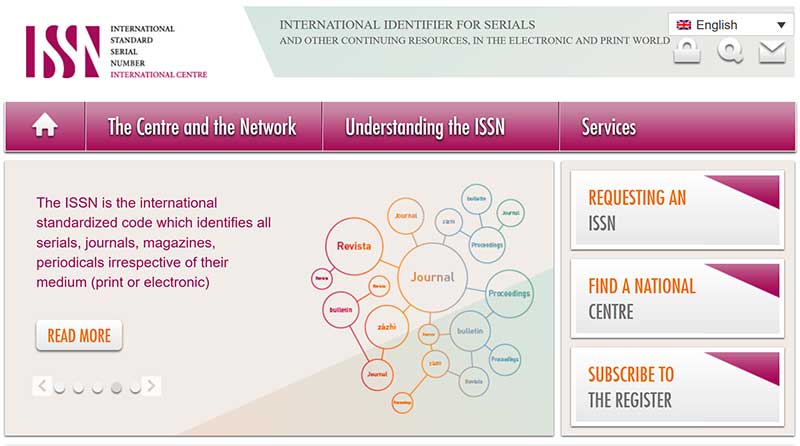
Как возможна моментальная публикация? Не только журналу «Проблемы педагогики» Международным центром в Париже присвоен печатный ISSN (2410-2881), но и сайту HTTP://PROBLEMSPEDAGOGY.RU Российской книжной палатой присвоен электронный ISSN (2413-8525). Это значит, что с момента публикации статьи на сайте HTTP://PROBLEMSPEDAGOGY.RU, автор получает полноценную электронную научную публикацию, на которую может ссылаться в своих научных трудах, а в момент выхода печатной версии журнала «Проблемы педагогики», полноценную печатную публикацию.
Журнал в обязательном порядке рассылается
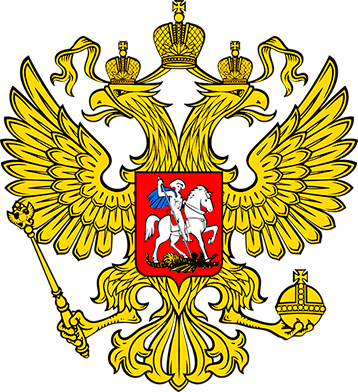 |
|
1. Библиотека Администрации Президента Российской Федерации, Москва. Адрес: 103132, Москва, Старая площадь, д. 8/5;
2. Парламентская библиотека Российской Федерации, Москва. Адрес: Москва, ул. Охотный ряд, 1;
3. Российская национальная библиотека (РНБ). Адрес: 191069, Санкт-Петербург, ул. Садовая, 18;
4. Научная библиотека Московского государственного университета. имени М.В. Ломоносова (МГУ), Москва. Адрес: 119899 Москва, Воробьевы горы, МГУ, Научная библиотека;
5. Государственная публичная научно-техническая библиотека Сибирского отделения Российской академии наук (ГПНТБ СО РАН), Новосибирск. Адрес: 630200, Новосибирск, ул. Восход, д. 15;
6. Библиотека Российской академии наук (БАН), Санкт-Петербург; Адрес: 199034, Санкт-Петербург, Биржевая линия, 1;
8. Дальневосточная государственная научная библиотека, Хабаровск. Адрес: 680000, Хабаровск, ул. Муравьева-Амурского, д. 1/72.
полный список >>>
|
Полный график выхода журналов и сборников конференций издательства «Проблемы науки»
|
Дата выхода журнала
|
Наименование журнала /
конференции |
Оплаченные статьи
принимаются до
(включительно)
|
Статус |
|
Ноябрь 2025 года
|
| 04.11.2025 Вторник |
Вестник науки и образования (электронный журнал) |
- |
Номер вышел |
| 07.11.2025 Пятница |
Отечественная юриспруденция (специализированное издание) eLIBRARY, Академия Google, Российский импакт-фактор, Роспечать, Книжная палата РФ. |
- |
Журнал вышел |
| 07.11.2025 Пятница |
Проблемы современной науки и образования (высокий импакт-фактор)
|
- |
Журнал вышел |
| 11.11.2025 Вторник |
International scientific review (Журнал Роскомнадзор РФ (Paris. France). Международная междисциплинарная зарубежная конференция) |
- |
Журнал вышел |
| 14.11.2025 Пятница |
Научный журнал (упрощенное оформление) eLIBRARY, Академия Google, Российский импакт-фактор, Роспечать, Книжная палата РФ. |
- |
На печати в типографии |
| 21.11.2025 Пятница |
Academy (упрощенное оформление) eLIBRARY, Академия Google, Российский импакт-фактор, Роспечать, Книжная палата РФ. |
- |
Журнал вышел |
| 21.11.2025 Пятница |
Наука и образование сегодня (упрощенное оформление) eLIBRARY, Академия Google, Российский импакт-фактор, Роспечать, Книжная палата РФ. |
- |
На печати в типографии |
| 21.11.2025 Пятница |
Вестник науки и образования (высокий импакт-фактор) |
- |
На печати в типографии |
| 30.11.2025 Воскресенье |
European research (London. United Kingdom. Международная междисциплинарная зарубежная конференция) eLIBRARY, Академия Google, Российский импакт-фактор. |
- |
Журнал вышел |
| 30.11.2025 Воскресенье |
Современные инновации (Международная междисциплинарная российская конференция) eLIBRARY, Академия Google, Российский импакт-фактор, Роспечать, Книжная палата РФ. |
- |
На печати в типографии |
|
Декабрь 2025 года
|
| 02.12.2025 Вторник |
Вестник науки и образования (электронный журнал) |
- |
Номер вышел |
| 05.12.2025 Пятница |
Проблемы современной науки и образования (высокий импакт-фактор)
|
- |
На печати в типографии |
| 09.12.2025 Вторник |
Проблемы педагогики (специализированное издание) eLIBRARY, Академия Google, Российский импакт-фактор, Роспечать, Книжная палата РФ.
|
- |
На печати в типографии |
| 12.12.2025 Пятница |
European science (рассылка в зарубежные вузы и научные центры) eLIBRARY, Академия Google, Российский импакт-фактор |
- |
Номер на согласовании |
| 16.12.2025 Вторник |
International scientific review (Сборник в США (Boston. USA). Международная междисциплинарная зарубежная конференция) |
15.12.2025 Понедельник |
Завершается набор номера |
| 19.12.2025 Пятница |
Вестник науки и образования (высокий импакт-фактор) |
18.12.2025 Четверг |
Завершается набор номера |
| 23.12.2025 Вторник |
Наука, техника и образование (высокий импакт-фактор) |
19.12.2025 Пятница |
Набор номера |
| 26.12.2025 Пятница |
Проблемы науки (упрощенное оформление) eLIBRARY, Академия Google, Российский импакт-фактор, Роспечать, Книжная палата РФ. |
23.12.2025 Вторник |
Набор номера |
|
Январь 2026 года
|
| 13.01.2026 Вторник |
Вестник науки и образования (электронный журнал) |
09.01.2026 Пятница |
Набор номера |
| 16.01.2026 Пятница |
Проблемы современной науки и образования (высокий импакт-фактор)
|
13.01.2026 Вторник |
Набор номера |
| 16.01.2026 Пятница |
International scientific review (Сборник в США (Boston. USA). Международная междисциплинарная зарубежная конференция) |
13.01.2026 Вторник |
Набор номера |
| 20.01.2026 Вторник |
Вестник науки и образования (высокий импакт-фактор) |
16.01.2026 Пятница |
Набор номера |
| 23.01.2026 Пятница |
Отечественная юриспруденция (специализированное издание) eLIBRARY, Академия Google, Российский импакт-фактор, Роспечать, Книжная палата РФ. |
20.01.2026 Вторник |
Набор номера |
| 27.01.2026 Вторник |
Economics (специализированное издание) eLIBRARY, Академия Google, Российский импакт-фактор, Роспечать, Книжная палата РФ. |
23.01.2026 Пятница |
Набор номера |
| 30.01.2026 Пятница |
Наука, образование и культура (упрощенное оформление) eLIBRARY, Академия Google, Российский импакт-фактор, Роспечать, Книжная палата РФ. |
27.01.2026 Вторник |
Набор номера |
Мы рецензируем, редактируем, корректируем Ваши работы. Если редакция получит статью в последний день, есть большая вероятность того, что мы не успеем обработать Вашу статью. Убедительная просьба, если Вы хотите опубликоваться в ближайшем номере, не откладывайте отправку заявки. Потратьте одну минуту, заполните и отправьте заявку в редакцию.
Если Вы хотите опубликоваться не в журнале «Проблемы педагогики», а в другом журнале издательства «Проблемы науки», его можно выбрать здесь >>>




